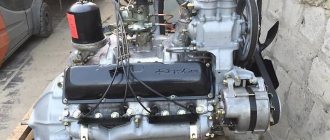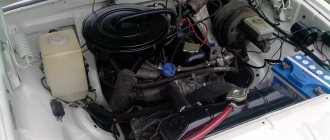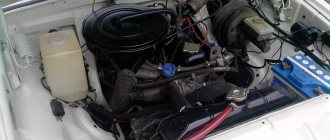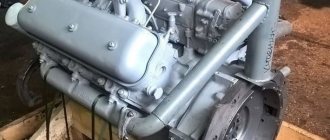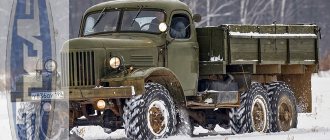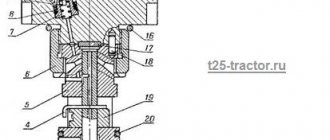The operating order of a 4-cylinder engine is designated as X―X―X―X where X is the cylinder numbers. This designation shows the sequence of alternating cycle strokes in the cylinders.
The order of operation of the cylinders depends on the angles between the crankshaft cranks, on the design of the gas distribution mechanism, and the ignition system of the gasoline power unit. In a diesel engine, the fuel injection pump takes the place of the ignition system in this sequence.
Of course, you don’t need to know this to drive a car.
It is necessary to know the operating order of the cylinders when adjusting valve clearances, changing the timing belt or setting the ignition. And when replacing high voltage wires, the concept of the order of operating cycles will not be superfluous.
What happens in the cylinders
The action taking place inside the cylinder is scientifically called the work cycle. It consists of valve timing.
The valve timing is the moment of the beginning of the opening and the end of the closing of the valves in degrees of crankshaft rotation relative to the dead points: TDC and BDC (top and bottom dead centers, respectively).
During one working cycle, one ignition of the air-fuel mixture occurs in the cylinder. The interval between ignitions in the cylinder directly affects the uniformity of engine operation. The shorter the ignition interval, the smoother the engine operation.
And this cycle is directly related to the number of cylinders. More cylinders means shorter ignition interval.
This is interesting: Cleaning the throttle valve - a trifle or a necessity?
Engine duty cycle
The operating cycle of an internal combustion engine, also known as the “Carnot cycle,” is an alternation of gas distribution phases. Its work consists of the following stages:
- The camshaft, rotating, opens the intake valve, and the air-fuel mixture is forced into the cylinder from the carburetor.
- The intake valve then closes and the fuel is ignited by an electric spark from the spark plug.
- A micro-explosion occurs in the combustion chamber, the energy of which pushes the piston located in it, connected to the crankshaft. The piston rotates the crankshaft, which through the transmission (clutch, cardan) transmits torque to the chassis.
- The camshaft then opens the exhaust valve and combustion products are removed through the exhaust manifold.
After this, the whole cycle repeats again.
The main condition for the operation of the cylinders is that they must act discordantly, and not in order. That is, it is unacceptable for the strokes to alternate in turn from 1 to 4 or, for example, up to the 16th cylinder.
Of course, this rule does not apply to two-cylinder internal combustion engines, like those installed in Oka. But now three-cylinder engines operate according to the 1-3-2 scheme. That is, the torque force on the crankshaft is first transmitted by the piston of the 1st, then the 3rd, and only then the 2nd cylinder.
Single cylinder engine repair
To study the features of repairing engines of this type, you need to know something about its main problems. But he has only one problem - high temperature. Since heat loss has become minimal, rubbing parts have become more vulnerable to mechanical stress, which means they need high-quality cooling. The fact is that the main liquid that comes into contact with these parts at the maximum level - oil - cannot provide proper heat removal. Therefore, two cooling systems are being developed for such a motor: air and liquid with a special thermostat system.
You can repair such an engine yourself. This requires a minimum of knowledge and a standard set of tools. If during operation there are various knocks that come from the cylinder head, then the valve mechanism needs to be adjusted. All adjustments are made with the engine removed and the valve cover removed. In addition, it is necessary to remove the special cover on the generator, under which the nut is located. By rotating this nut, we rotate the crankshaft to set the piston to top dead center. To determine this moment, it is necessary to bring the special marks on the rotor into alignment. After this, measuring probes are installed under the camshaft cams and the thermal clearances of the valves are measured. Naturally, this procedure must be performed on a cold engine, otherwise the adjustment result will not be correct.
After this, the motor must be assembled and checked. It is installed on the unit and started up. If it runs smoothly without noise, then the valve adjustment was successful.
That's all. This is how you can easily repair a single-cylinder four-stroke engine with your own hands without the help of car service specialists. This will help you save a lot on their services and give you invaluable experience.
How does the work cycle work?
The entire process of fuel injection, ignition, piston operation and exhaust gas emission is called the “work cycle”. Let's consider it using the example of a gasoline four-stroke internal combustion engine, standard for many passenger cars.
The cycle, as the name implies, is divided into four cycles of work:
- Inlet.
In this state, the intake valve is open, the exhaust valve, on the contrary, is closed, the piston moves in the downward direction, and the prepared air-fuel mixture enters the cylinder.
- Compression.
All cylinder valves are closed, and the piston moves upward and compresses the previously injected mixture to the specified parameters.
- Working progress.
The valves are still open and the mixture is ignited, producing gases. Their pressure begins to move the piston down, and the latter rotates the crankshaft.
- Release.
How does a single-cylinder four-stroke engine work?
Currently, internal combustion engines are used in a large number of different technical means, and these means are not only cars. This type of engine, like a two-stroke internal combustion engine, is used in motor vehicles and in specialized devices intended for construction, for example, a chainsaw. These units are represented by four-stroke internal combustion engines, having one cylinder each, and not, as in a modern car, four. In this article you will learn how a single-cylinder four-stroke engine works, its operating principle and repair.
Cylinder sequence
The cylinders have numbers; in the documentation they are described in ABCD format, where instead of letters a digital designation is indicated. The numbering order starts from the timing chain or belt side - from the cylinder furthest from the gearbox. The one who wears number 1 is called the main one.
Important: if the cylinders operate in series, they should not be located next to each other. It is with this condition in mind that motor manufacturers have developed certain cycle order schemes.
The cylinders are equipped with valves through which gases enter and exit. The valves are controlled by a special device - a camshaft, on the surface of which special cams are located in a special way. It is their location that is responsible for the order of operation: the cam profile and its height affect the closing and opening moments, the size of the cross-section of the passage for gases, as well as how the valve will move depending on the current crankshaft angle.
One of the camshaft options:
Crankshaft:
A standard 4-stroke cycle of a standard internal combustion engine takes 2 revolutions, or 720 degrees (360 and 360). The “cranks” located on the shaft are shifted by a certain angle so that the force from the engine pistons is constantly transmitted to the shaft. The mentioned angle is a value that depends on the engine model, its stroke rate, and the number of cylinders.
This is interesting: Repair and replacement of the ignition switch
Opposite type
It's no secret that on a V-like block the angle of inclination of the 2 parts is ninety or sixty degrees. If it is one hundred and eighty degrees, then it is a boxer engine.
Here the cylinders are placed opposite each other, in a horizontal order. The crankshaft in these devices is common, placed in the center, and the pistons move away from it.
How do V6 internal combustion engines work?
To ensure the efficiency of the operation of today's six-cylinder engines, it is also built according to a special system. The typical operating order of an inline 6 cylinder engine is the 1–5–3–6–2–4 method. In the form factor under consideration, the power unit is quite long and requires a large engine compartment.
To reduce dimensions, a “VE-like” system is sometimes used. Diagram of the operating order of the “pots” of 6 cylinder modern engines, V-shaped form factor – activation sequence 1-4-2-5-3-6.
Interesting: the six-cylinder design in question is considered one of the least balanced.
A unit from Audi, for which the specified operation order of a V-shaped six-cylinder automobile engine is relevant:
Theory of internal combustion engine operation
The general principle of operation of engines running on gasoline or diesel fuel is known, perhaps, to everyone - fuel, burning in the cylinders, creates gas pressure that pushes the pistons, and then the force is converted into torque going to the wheels.
In order for the engine to operate evenly, fuel combustion does not occur in all cylinders at the same time, but in a certain order. The following are responsible for its compliance:
- gas distribution mechanism design;
- the angles between the cranks of the car crankshaft;
- cylinder arrangement - V-shaped or in-line;
- device of the ignition system for gasoline cars, and fuel injection pump for diesel cars.
Useful tips and tricks
First of all, if problems or malfunctions occur in the operation of the engine, as part of the diagnostics it is important to know what order of operation of the cylinders of a particular internal combustion engine. This allows you to more accurately identify problem cylinders, more accurately check the operation of the ignition system, etc.
In turn, during engine repair, especially if an internal combustion engine of this type has not been repaired by a specialist before, it is strongly recommended to study in advance the operating order of the cylinders of a particular power unit. This allows you to avoid a number of problems and errors when assembling the motor.
Tact
The movement of the piston inside the engine cylinders is called the duty cycle. The cycle consists of valve timing phases, which can be used to determine the moment of opening and closing of the valves. In a four-stroke vehicle, the full cycle occurs after turning the crankshaft by 720 degrees, in a two-stroke vehicle - by 360.
To provide the shaft with constant force during the power stroke in the engine cylinders, the knees of the unit are located at a certain angle relative to each other. The angle is affected by the number of cylinders, the type of installation and the location of the cylinders.
How to determine the operating order of internal combustion engine cylinders depending on the strokes.
| Half-turns of the crankshaft in the cylinders of a diesel and carburetor unit | Angle of rotation | Engine cylinder numbering | |||
| 1 | 2 | 3 | 4 | ||
| First | 0-180 | Exhaust gas release | Power stroke | Fuel and air intake | |
| Second | 180-360 | Fuel and air intake | Exhaust gas release | Compression of the air-fuel mixture | Working stroke |
| Third | 360-540 | Compression of the air-fuel mixture | Fuel and air intake | Working stroke | Exhaust gas release |
| Fourth | 540-720 | Working stroke | Compression of the air-fuel mixture | Exhaust gas release | Fuel and air intake |
Engine Tactics
The operation of engine cylinders consists of the following stages:
- Intake - the piston moves to bottom dead center, and the combustion chamber is filled with the air-fuel mixture through the intake valve. The exhaust valve is closed.
- Compression - both valves are closed, the piston moves to top dead center, compressing the fuel composition. Due to compression, the temperature in the chamber increases significantly, and the pressure in the engine cylinder also increases. An important parameter that affects the efficiency of a car is the compression ratio. The indicator means the ratio of the complete filling of the cartridges and the volume of the combustion chamber. For cars with a high octane number, high-octane fuel is required.
- The working stroke is when the valve is in the closed position, the mixture is ignited by the spark plug. Under the influence of pressure in the cylinder of the car engine during fuel combustion, the piston goes down, rotating the crankshaft. For efficient performance, it is necessary that the fuel burns completely before the piston reaches BDC. This is ensured by setting the ignition timing. In modern cars, adjustment is carried out by a built-in electronic unit. Older models are equipped with a mechanical regulator.
- Exhaust - the power stroke ends with the exhaust of exhaust gases from the engine cylinders. At this stage, an important process occurs - purging the engine cylinders. Purging of the engine cylinders is ensured by the simultaneous opening of the intake and exhaust valves. After the piston reaches TDC, the intake stroke begins.
4-cylinder engine, most common
As mentioned above, 4 cylinder engines are the most common in the automotive industry. Based on the number of pairs of valves per cylinder, they are divided into two groups.
8-valve engines are installed mainly on models in the low price group. They have one intake and exhaust valve for each cylinder - a total of 8 valves.
The peculiarity of such internal combustion engines is the use of a single camshaft that controls the injection and exhaust gas removal systems. To operate it, a chain or belt mechanism is used. Such a system is easy to repair and maintain, and due to the simplicity of the design, the cost of the car is significantly reduced.
In more expensive car models, each engine cylinder has two pairs of intake and exhaust valves - a total of 16 valves. Such systems use two camshafts, the operation of which requires a complex gas distribution mechanism.
The use of two intake valves provides more fuel per stroke, which increases engine power and efficiency. Also, thanks to the presence of two exhaust valves, fuel consumption is reduced.
The principle of operation of a diesel engine
The diesel operating cycle differs from the atmospheric one in the method of mixture formation and ignition. Instead of the finished mixture, air is supplied to the combustion chamber. Due to compression, the temperature in the CPG of a diesel engine increases. Then fuel is supplied through the injectors.
Due to the high temperature and pressure in the cylinders of a diesel unit, diesel fuel spontaneously ignites - a working stroke occurs. The working stroke ends with the exhaust of exhaust gases.
Start numbering
There is no single standard for determining cylinder numbering. Therefore, how cylinders in an engine are counted should be looked at in the technical instructions for the vehicle.
The numbering of cylinders in an engine is influenced by the following factors:
- type of running vehicle: rear-wheel drive or front-wheel drive;
- arrangement of cylinders in the engine: in-line, V-shaped, opposed;
- direction of rotation of the crankshaft;
- number of cylinders in the engine.
For those who are planning to carry out maintenance, you need to know how to check the engine cylinders. Where the first cylinder of an engine is located can be determined by several factors:
- How to count engine cylinders depending on the type of drive: for brands with front drive wheels, the first cylinder is counted on the passenger side.
- On rear-wheel drive models, the firing order of the engine cylinders begins on the radiator side.
How many cylinders are in the engine, the installation method depends on the manufacturer. Some manufacturers use a reverse numbering option, in which the count starts from the passenger compartment. In French automakers, the calculation starts from the gearbox or depending on the torque side.
In two rows
How to make a huge in-line internal combustion engine smaller?
- The engine can be "divided" in half, placing the two parts next to each other and having the pistons turn one crankshaft. This structure resembles the letter “V”.
- Here the combustion chambers are placed in two rows at an angle. This arrangement is quite common among manufacturers and is inferior only to the in-line “four”.
8 combustion chambers in this configuration are placed 4 in 2 rows. This is the most compact assembly for large-sized motors. If we talk about structures with 12 cylinders, the only difference is their number.
Repair of car components
The cylinder block structure consists of parts that operate in aggressive conditions, and therefore are often subject to breakage and wear.
Restoring an engine cylinder block consists of the following operations:
| No. of works | Operations Performed | Technical equipment. |
| 1 | Grinding the surface of the crankshaft bearing stop | Vertical milling machine |
| 2 | Replacing worn camshaft bushings | Press-fitting device |
| 3 | Repairing threaded holes | Drilled equipment, set of drills, lantern, die |
| 4 | Pressing out the fastening pins | Special press |
| 5 | Boring, repair of engine CPG cover. Adjustment by plane, installation by holes | Vertical milling machine |
| 6 | Processing the body for sleeves and boring for thrust edges | Vertical boring machine |
| 7 | Boring of main bearing seats | Horizontal boring machine |
| 8 | Gas-thermal spraying on treated bearing seats | Special technological equipment |
| 9 | Double-circuit boring of the body | Honing machine |
| 10 | Washing the engine and cleaning the oil channels | Equipment for jet washing of parts. |
| 11 | Painting the block | Spray gun. Compressor. |
Repair of the engine cylinder block ends with a control inspection on the test plate. Using a feeler gauge and indicator devices, the installation rigidity and alignment of the mounting components in the engine cylinder block are checked. After the engine cylinder body has been restored, a leak test is carried out.
Cylinder head assembly
Repair of the engine cylinder head is performed for the following reasons:
- broken drive shaft belt;
- cylinder head deformation due to overheating;
- duration of service lines;
- incorrect assembly after repair of the unit cylinder block.
Defects of engine cylinder head parts
You can restore defects using the following steps:
- grinding valves;
- the cylinder head is polished;
- gaskets and belts are being replaced;
- Bushings and valve seats are bored.
Post-repair control
After troubleshooting, the cylinder head is painted and the pressure in the cylinder is checked.
An indicator that indicates the effective performance of engine cylinder block parts is compression.
What is the pressure in the cylinders of different brands of engines?
The final stage, painting
Before painting the engine cylinder block, it is necessary to carry out preparatory operations, which consist of the following points:
- cleaning parts from adhering dirt, oil, carbon deposits;
- removing traces of corrosion (if any);
- grinding contaminated threaded channels.
The cylinder head is painted separately so that the air and oil passages do not become clogged.
The operation of the cylinders is not dependent on painting, but it is important to protect the block from contamination.
How to paint the engine depends on financial capabilities. Online stores offer a wide variety of products that can be used to treat the surface of parts after repairing the engine block and cylinders.
Technical specifications
| GENERAL INFORMATION |
Cylinder arrangement and direction of rotation of the ignition distributor
Cylinder arrangement (belt side)
| Right side (back) | 1–3–5 |
| Left side (at the radiator) | 2–4–6 |
| Cylinder operating order | 1–2–3–4–5–6 |
Cylinder head
| 1 – left exhaust manifold; 2 – gasket; 3 – thermal protective screen of the exhaust manifold; 4 – gasket; 5 – right exhaust manifold; 6 – thermal protective screen of the exhaust manifold; 7 – cylinder head gasket; 8 – toothed belt casing; 9 – right cylinder head; 10 – camshaft that controls the intake valves; 11 – camshaft that controls the exhaust valves; 12 – washer; 13 – thrust ring; 14 – camshaft pulley; 15 – retaining ring; 16 – gasket; 17 – cylinder head cover; 18 – gaskets; 19 – intake manifold; 20 – idler pulley bracket; 21 – gasket; 22 – cooling system fitting; 23 – gasket; 24 – air intake bracket; 25 – EGR pipe; 26 – gaskets; 27 – EGR valve and vacuum modulator; 28 – vacuum pipes; 29 – air intake; 30 – gaskets; 31 – bypass pipe of the cooling system; | 32 – thermal protective screen of the bypass pipe; 33 – sealing washer; 34 – cylinder head cover; 35 – gasket; 36 – camshaft bearing cover; 37 – camshaft that controls the intake valves; 38 – camshaft that controls the exhaust valves; 39 – rear plate of the cylinder head; 40 – spark plug pipe laying; 41 – left cylinder head; 42 – left engine eye; 43 – cylinder head gasket; 44 – adjusting gasket; 45 – valve pusher; 46 – upper spring plate; 47 – spring; 48 – spring seat; 49 – valve guide; 50 – valve; 51 – exhaust bypass pipe; 52 – gasket; 53 – thermal protective screen of the exhaust manifold; 54 – camshaft sealing ring; 55 – crackers; 56 – sealing ring; 57 – thrust ring; 58 – gaskets |
Cylinder head
| Non-flatness: | |
| – 3VZ-FE engine (1992 and 1993): | |
| • cylinder head | 0.099 mm |
| • intake manifold | 0.099 mm |
| • an exhaust manifold | 1.0 mm |
| – engine 1MZ-FE (1994): | |
| • cylinder head | 0.099 mm |
| • intake manifold | 0.078 mm |
| • an exhaust manifold | 0.49 mm |
Camshaft
| Valve clearance (cold engine): | |
| – intake valves | 0.127 – 0.23 mm |
| – exhaust valves | 0.28 – 0.38 mm |
| Neck diameter | 26.940 – 26.960 mm |
| Bearing clearance: | |
| – nominal | 0.035 – 0.071 mm |
| – minimal | 0.099 mm |
| Jaw height: | |
| – 3VZ-FE engine (1992 and 1993) | |
| Camshaft controlling intake valves: | |
| – nominal | 42.158 – 42.260 mm |
| – maximum permissible | 42,000 mm |
| – 1MZ-FE engine (since 1994) | |
| Camshaft controlling intake valves: | |
| – nominal | 42.110 – 42.210 mm |
| – maximum permissible | 42.050 mm |
| Camshaft controlling intake valves: | |
| – nominal | 41.960 – 42.050 mm |
| – maximum permissible | 41.810 mm |
| Camshaft end play | |
| – nominal | |
| • 3VZ-FE engine (1992 and 1993) | 0.033 – 0.078 mm |
| • engine 1 MZ-FE (since 1994) | 0.040 – 0.088 mm |
| – maximum permissible | 0.119 mm |
| Camshaft gear play: | |
| – nominal | 0.02 – 0.20 mm |
| – maximum permissible | 0.47 mm |
| Distance between the ends of the camshaft gear spring | 22.5 – 22.9 mm |
Valve pusher
| Diameter | 30.96 – 30.97 mm |
| Pusher Channel Diameter | 31.00 – 31.018 mm |
| Pusher clearance in head: | |
| – nominal | 0.022 – 0.050 mm |
| – maximum permissible | 0.071 mm |
Oil pump
| Gap between outer rotor and housing: | |
| – nominal | 0.099 – 0.170 mm |
| – maximum permissible | 0.299 mm |
| Rotor axial play: | |
| – nominal | 0.030 – 0.088 mm |
| – maximum permissible | 0.149 mm |
Tightening torques
| Engine 3VZ-FE (1992 and 1993) | |
| Exhaust manifold nuts | 40 Nm |
| Crankshaft pulley bolt | 250 Nm |
| Idler pulley bolts: | |
| - number 1 | 35 Nm |
| - number 2 | 40 Nm |
| Toothed belt tension mechanism | 28 Nm |
| Camshaft pulley | 110 Nm |
| Cylinder head bolts: | |
| – stage 1 | 35 Nm |
| – stage 2 | turn to an angle of 90° |
| – stage 3 | turn to an angle of 90° |
| Oil pump bolts: | |
| – bolt head 12 mm | 35 Nm |
| – bolt head 14 mm | 40 Nm |
| Flywheel/drive plate | 85 Nm |
| Engine 1MZ-FE (since 1994) | |
| An exhaust manifold | 50 Nm |
| Crankshaft pulley bolt | 220 Nm |
| Idler pulley bolts: | |
| - number 1 | 35 Nm |
| - number 2 | 45 Nm |
| Toothed belt tension mechanism | 28 Nm |
| Camshaft pulley | 130 Nm |
| Cylinder head bolts: | |
| – stage 1 | 55 Nm |
| – stage 2 | turn to an angle of 90° |
| Flywheel/drive plate | 85 Nm |
What about now?
Contrary to popular belief, 8-cylinder engines are installed not only in luxury foreign cars, but also in ordinary tractors, trucks and construction equipment. As with weaker engines, the most balanced type is the in-line engine type. In other words, when all the cylinders are located in a row. They were used to equip the most expensive cars for a long time. This design was especially appreciated in America. However, the record holders here are the Germans, who highly value the balance and reliability of the in-line engine.
But even they, over time, had to switch to V-twin engines. The reason is simple and banal - the eight-cylinder Python simply did not fit in the standard engine compartment of modern cars.
Where are 12-cylinder engines used?
For air and water transport, such engines are quite common. As for the modern automotive industry, they are often installed in production models by Ferrari and Lamborghini. On the Russian market you can find W12 engines in cars of the German automaker Volkswagen. Recently, 12-cylinder engines began to be produced in Barnaul, using the pre-war V12 diesel engine as a prototype.
Such power plants are installed on diesel locomotives, on drilling rigs, and as a drive for pumps and compressor units.
In addition to Ferrari, such engines are installed in cars from Rolls-Royce and Pagani; these are mostly classic V12s, most suitable for use in passenger cars.
How to profitably exchange a used car
To guarantee the legality of the used car exchange service and its objective cost, the purchase and sale process should be carried out at a trusted auto center. Here the client will be offered:
- Diagnostics of the old model, on the basis of which its cost will be determined;
- Selection of cars for exchange, completely new or with a clean mileage history: all cars undergo forensic examination, therefore the car dealership will never sell a car with a “dark past”;
- Legal support of the transaction: the client enters into a notarized agreement and, if necessary, can use the credit services of the car dealership’s partner bank;
- Efficiency of the service: the client does not need to look for buyers for his vehicle; he does not need to settle issues with the traffic police or the bank. The listed functions are the task of the auto center.
Read here! Engine sump
Thus, with minimal documents, it is possible to buy an improved car within one to three days. The used car exchange service makes it possible to regularly change the owner’s vehicle fleet by purchasing its best models.
The order of operation of the cylinders in different engines
So, we have become acquainted with the theoretical position about the influence of the ignition interval on the uniformity of operation. Let's consider the traditional order of operation of the cylinders in engines with different cylinder layouts.
- operating order of a 4-cylinder engine with a crankshaft journal offset of 180° (interval between ignitions): 1-3-4-2 or 1-2-4-3;
- operating order of a 6 cylinder engine (in-line) with a firing interval of 120°: 1-5-3-6-2-4;
- operating order of an 8 cylinder engine (V-shaped) with a 90° firing interval: 1-5-4-8-6-3-7-2
In all engine manufacturers schemes. The firing order of the cylinders always starts with master cylinder #1.
Knowing the firing order of your vehicle's engine cylinders will no doubt be helpful to you in order to control the firing order when performing certain repairs such as ignition adjustment or cylinder head repair. Or, for example, for installing (replacing) high-voltage wires and connecting them to spark plugs and distributors.
Good luck using your knowledge of cylinder firing order.
Home →
Device →
Engine →
8 cylinder
In 8-cylinder engines, the cranks are installed at an angle of 90 degrees to each other, since the engine has 4 strokes, then for each stroke 2 cylinders work simultaneously, which affects the elasticity of the engine. The 12-cylinder runs even smoother.
In such engines, as a rule, the most popular is the same sequence of cylinder operation: 1-5-6-3-4-2-7-8.
But Ferrari used a different scheme - 1-5-3-7-4-8-2-6
In this segment, each manufacturer used only a known sequence.
Five-cylinder
These are units with 5 cylinders standing in a row. The relative displacement of the crankpins is 72 degrees. There are both two- and four-stroke samples; for the first (2 strokes), the standard order of optimal operation of the cylinder block for these engines is the activation sequence 1–2–4–3–5. This ensures uniform combustion of the fuel. These motors are widely used in marine technology.
On passenger cars, engineers report a different order for the operation of the “pots” of 5-cylinder typical engines - the 1-2-4-5-3 system.
Cylinder block:
With offset
The developers have found an alternative to make a powerful and at the same time small power mechanism for middle-class passenger cars. The offset design is a V-block with 6 cylinders.
They are located opposite each other diagonally. 6 cylinders tilted at fifteen degrees form a rather narrow and short structure.
Common motors and cylinder operating order
As an example, to begin with, let's consider 4-cylinder in-line ZMZ engines and similar units. For example, the operating order of the ZMZ-402 cylinders is: 1-2-4-3, while the ZMZ-406 is: 1-3-4-2. The Audi 80 B3 engine has a 1-3-4-2 operating order. The alternation of cycles occurs every 1800.
As you can see, the operating order of a single-row 4-cylinder engine can be 1-3-4-2 (typical for VAZ) or 1-2-4-3 (in the case of GAZ engines).
If we talk about a 6-cylinder in-line engine, then the sequence is: 1-5-3-6-2-4, and the interval between ignition is 1200. In turn, in relation to an 8-cylinder V-shaped engine: 1-5-4 -8-6-3-7-2, the interval between ignitions will already be 900.
Let’s also add that the operating order of the 12-cylinder W-shaped engine is as follows: 1-3-5-2-4-6 for the left cylinder heads, while for the right ones 7-9-11-8-10-12. To put it simply, in such engines the order of operation of the cylinders is divided into two types (similar to in-line “fours”): 1-3-4-2 and 1-2-4-3.
The firing order of the V-6 engine is also different. There are versions where the order is: 1-6-3-5-2-4 or 1-4-2-5-3-6. At the same time, the order of operation of an in-line engine with 6 cylinders and ignition of the mixture is: 1-5-3-6-2-4. It is also noteworthy that the Japanese Mitsubishi MIVEC engines, 6G72, have a cylinder operating order of 1-2-3-4-5 -6.
- Please note, as mentioned above, six-cylinder V-shaped engines are the most problematic in terms of balancing, that is, they are quite heavily vibration-loaded.
To reduce vibrations and improve balancing during engine operation, the design of the internal combustion engine includes devices, solutions and mechanisms for balancing the moments of inertia of the pistons, the upper parts of the connecting rods, etc. To put it simply, such a motor contains counterweights, flywheels, balance shafts, pulleys and other elements.
Also, in order to reduce vibration levels, manufacturers use different operating orders for the cylinders. As an example, on an 8-cylinder internal combustion engine, the alternation of strokes can be 1-5-4-2-6-3-7-8 or the cylinder operating order 1-5-4-8-6-3-7-2 ( BMW M60), 1-3-7-2-6-5-4-8, etc. It turns out, as is the case with other types of power units, 8-cylinder engines also do not have a clearly defined order of operation of the cylinders.
ICE for 8 cylinders
Due to their dimensions, the engines are made in a V-shaped configuration.
Eight-cylinder internal combustion engine from Chevrolet:
Possible order of operation of an eight-cylinder engine of a modern car:
- option 1–5–4–2–6–3–7–8 – main;
- the principle 1–8–4–3–6–5–7–2 is another variation.
This difference is imaginary and is due to a difference in the number of cylinders. In the USA, cylinder 1 is located in front in the direction of travel of the car, on the left, and in the European system - on the right. The cylinders are numbered in a checkerboard sequence, backwards and left to right, so both classifications represent essentially the same thing, as illustrated by the diagram:
The interval between fuel ignition is 90 degrees.
Preparing the car
The machine being manipulated is placed on a flat surface. The driver's cabin reclines and locks. The upper part of the gas distribution mechanism is dismantled and the pump is turned off.
KamAZ 43118:
Devices:
- Keys: open-end for 13, ring for 14;
- Screwdrivers;
- Steel rod;
- Set of measuring plates.
Fixing the main chamber piston at the top
- Check the fixation force of the camera heads;
- Move the flywheel stop device down;
- Remove the flywheel housing protection plate;
- Insert the steel rod into the hole in the flywheel, turn clockwise until the product stops. Position – beginning of mixture injection (cylinder one).
Flywheel retainer, KamAZ engine:
Setting gaps
- Rotate the flywheel (2 holes – 60°, each 30°);
- Adjust the spacing of the first pair of cameras (1st and 5th). Using a 14 ring wrench, loosen the nuts
- adjusting screws. Use the 0.3 plate to adjust the intake valve, and the 0.4 plate to adjust the exhaust valve.
- Fix the nut, force 33-41 Nm.
- Adjust the spacing in chambers one through eight.
Setting up KamAZ 740, 6520, 5511 valves and other modifications:
- 180 degrees – 4th, 2nd;
- 180 degrees – 6th, 3rd;
- 180 degrees – 7th, 8th.
Adjusting clearances KamAZ:
A little about internal combustion engines
Knowledge about the structure and operation of a car will be a big plus for any car enthusiast. This is especially true for the engine - the most important element and heart of the iron horse. ICE has a lot of varieties - starting from the type of fuel and ending with small nuances unique to each car.
But the essence of the work is approximately the same:
- The combustible mixture (fuel and oxygen, without which nothing will burn) enters the engine cylinder and is ignited by the spark plugs.
- The energy of the explosion of the mixture pushes the piston inside the cylinder, which, when lowered, rotates the crankshaft. When rotating, the crankshaft lifts the next cylinder to the camshaft (which is responsible for supplying the mixture through the valves).
Thanks to the sequential operation of the cylinders, the crankshaft is in constant motion, generating torque. The more cylinders, the easier and faster the crankshaft will rotate. So a diagram emerged, familiar even to schoolchildren who do not understand hardware - more cylinders - more powerful engine.
Definition
Cylinder firing order is the sequence in which the cylinders fire alternately. Otherwise, we can call it a sequence of alternating expansion cycles. Factors influencing it: the number of cylinders, the nature of their arrangement, the design of the engine (in particular, the camshaft and crankshaft), as well as the interval between flashes. To be more precise, it is influenced by the location of the cylinders, crank journals and camshaft cams. The smooth operation of the engine, it is worth noting, depends, among other factors, on the sequence of strokes.
Factors determining cylinder numbering
The numbering of cylinders in automobile engines depends on:
- engine design
- drive designs
- engine location option - longitudinal (installed along the direction of travel of the car) or transverse
- motor rotation direction
We remind you that in car engines the cylinders can be located:
a) in a row vertically;
b) in a row obliquely;
c) in two rows obliquely;
d) in two rows opposite each other (the so-called boxer engine, which is used in Subaru cars).

